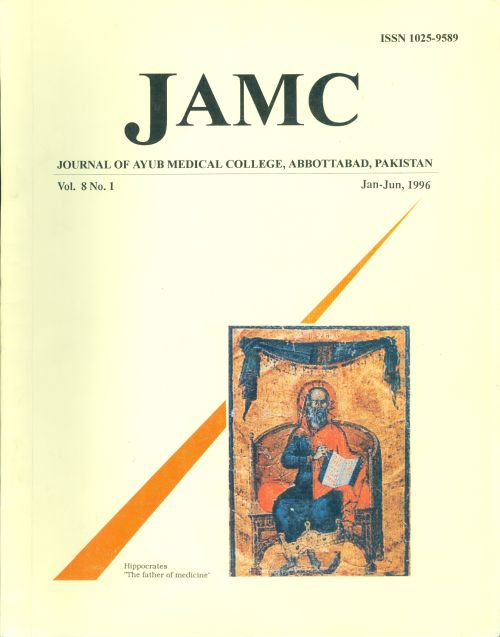FIRST YEAR MORTALITY AND MORBIDITY AFTER AMI IN PESHAWAR
Abstract
Two hundred and ten patients with acute myocardial infarction (AMI) were studied for mortality and morbidity in a tertiary hospital setting. Out of these, 117(56%) had anterior MI. 73(35%) had inferior MI, 12(6%) had non Q- wave MI, 8(4%) had lateral MI and 6(3%) had both interior and inferior MI. 134(64%;) received thrombolytic therapy. 37(18%) were diabetic and 33(16%) were hypertensive. 163(78%) could be followed for one year. The total first year mortality was 48(23%). The in- hospital mortality after AMI was 29(14%). Among those alive at the end of first year 90(71%) were in NYHA functional class I 28(22%;) in class II. 6(14%) in class III and 3(2%) in class IV.References
Christopher R. Davidson's text book of Medicine, Sixth
Edition, p 315.
Titenbrunn. The impact of coronary thrombolysis after
MI. Fibrinolysis, 1989; 3:1.
Pell's and Fayerweather. Trends in the incidence of Ml
and in associated mortality and morbidity in the large
employed population. 1957-1983. N. Eng. J. of Med.
; 312: 1005.
Elveback LR. Coronary heart disease in residents of
Rochester. Minnesota. Prognosis of patients with CAD
based on initial manifestations. Mayo Clin Proc, 1985;
: 305.
Lee TH. The coronary care unit turns 25; Historical
trends and future directions. Ann Intern Med, 1988;
: 887.
British Heart Foundation working group. Role of
general practitioner in managing patients with MI:
Impact of thrombolytic treatment. BMJ, 1989; 299:
Pressley JC. Basic emergency medical care of patients
with AMI. Initial pre-hospital characteristics and inhospital
complications. J Am Coll Cardiol, 1984; 4:
Bain. The thrombolysis in Ml. (TIMI) trial phase II.
Additional information and perspectives. J Am Coll
Cardiol, 1990; 15: 1188.
Issue
Section
License
Journal of Ayub Medical College, Abbottabad is an OPEN ACCESS JOURNAL which means that all content is FREELY available without charge to all users whether registered with the journal or not. The work published by J Ayub Med Coll Abbottabad is licensed and distributed under the creative commons License CC BY ND Attribution-NoDerivs. Material printed in this journal is OPEN to access, and are FREE for use in academic and research work with proper citation. J Ayub Med Coll Abbottabad accepts only original material for publication with the understanding that except for abstracts, no part of the data has been published or will be submitted for publication elsewhere before appearing in J Ayub Med Coll Abbottabad. The Editorial Board of J Ayub Med Coll Abbottabad makes every effort to ensure the accuracy and authenticity of material printed in J Ayub Med Coll Abbottabad. However, conclusions and statements expressed are views of the authors and do not reflect the opinion/policy of J Ayub Med Coll Abbottabad or the Editorial Board.
USERS are allowed to read, download, copy, distribute, print, search, or link to the full texts of the articles, or use them for any other lawful purpose, without asking prior permission from the publisher or the author. This is in accordance with the BOAI definition of open access.
AUTHORS retain the rights of free downloading/unlimited e-print of full text and sharing/disseminating the article without any restriction, by any means including twitter, scholarly collaboration networks such as ResearchGate, Academia.eu, and social media sites such as Twitter, LinkedIn, Google Scholar and any other professional or academic networking site.









